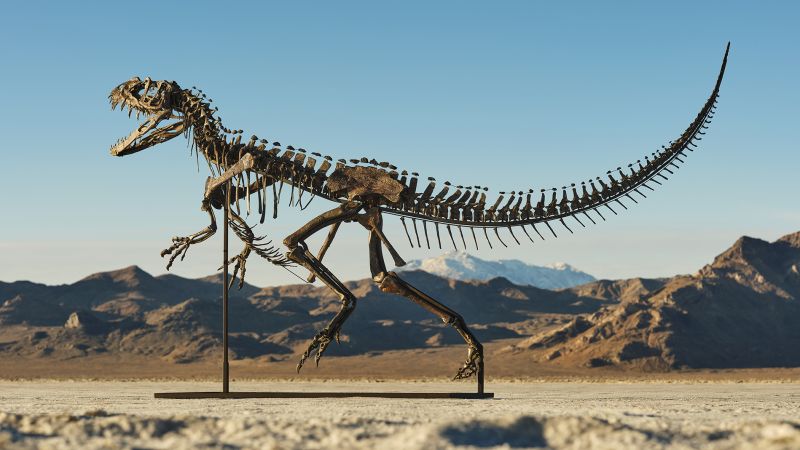In a remarkable event that has captured the attention of collectors and scientists alike, a Ceratosaurus fossil—one of only four known to exist—was auctioned off for an astounding $30.5 million at Sotheby’s in New York. This rare dinosaur fossil has been hailed by the auction house as “one of the finest and most complete examples of its kind ever found.” This significant sale highlights not only a burgeoning interest in paleontological specimens but also the increasing monetary value attributed to such fossils.
The Ceratosaurus fossil, notable for being the only juvenile among the four known specimens, was sold dramatically, after a heated six-minute bidding war among a total of six different bidders. Initially, the fossil was valued between $4 million and $6 million, a figure it far surpassed by the time the gavel fell. Once merely a restricted piece of scientific interest, it found itself in a premium auction context where its worth skyrocketed amid escalating bidder excitement.
From a scientific perspective, the Ceratosaurus nasicornis was a formidable carnivore characterized by its unique nasal horn, elongated teeth, and bony armor along its back and tail. According to Sotheby’s, the skeleton measures six feet three inches (approximately 1.9 meters) in height and is about 10 feet eight inches (or 3.25 meters) long. The fossil comprises 139 bone elements, including a remarkably complete skull formed by 57 distinct bones. This specimen was unearthed in 1996 at Bone Cabin Quarry located in Wyoming and dates back to the late Jurassic period, roughly 150 million years ago.
Previously, this fossil has been displayed at the Museum of Ancient Life in Thanksgiving Point, Utah, for an impressive duration from 2000 to 2024. Interestingly, despite this extensive exhibition, the Ceratosaurus has yet to be formally studied or described in a scientific journal, indicating a potential treasure trove of research opportunities that might follow its purchase. According to Sotheby’s, the buyer plans to loan the fossil to a knowledgeable institution, a fitting choice for such an extraordinary piece.
The auction didn’t solely feature the dinosaur fossil; a meteorite, known as the largest piece from Mars on Earth, was also sold for $5.3 million during the same event. Cassandra Hatton, the global head of science and natural history at Sotheby’s, shared insights on the human fascination with natural history, stating that such results reflect a profound curiosity about the cosmos and Earth’s ancient history, highlighting that top collectors often view these items through a scientific as well as an artistic lens.
From a historical perspective, Mark Westgarth, a professor at the University of Leeds in England, highlighted the ongoing revival of interest in fossils. He noted the sale of Apex the Stegosaur, which fetched a staggering $44.6 million in July 2024, exemplifying this trend. He explained that this interest might be driven by collectors’ increasing desire for distinction, as these dinosaur specimens exhibit a unique aesthetic appeal, being both sculptural and awe-inspiring.
However, contrasting opinions exist regarding the implications of such high-value sales. Steve Brusatte, a renowned paleontologist from the University of Edinburgh, voiced his concerns about who can afford such fossils, indicating that the financial burden is likely an obstacle for museums or educational institutions. He expressed apprehension that the Ceratosaurus fossil may vanish into obscurity, potentially hidden in a private collection and seldom made accessible for public education or inspiration.
As the auction world becomes increasingly steeped in the financialization of the natural world, Brusatte worries that this trend might ultimately preclude wider accessibility. He articulated a fundamental fear that dinosaur skeletons selling for millions represents not just a financial challenge but a cultural one, where public engagement and education could diminish.
Conversely, Westgarth posited that there exists a symbiotic relationship between the fossil market and broader research endeavors. By referencing the historical figure of Mary Anning, a 19th-century fossil hunter whose commercial activities spurred scientific interest, he argued that the current market dynamics could spark future research initiatives, particularly since the buyer’s intention to loan the Ceratosaurus to institutions could catalyze further scientific discovery and understanding.
Ultimately, the sale of the Ceratosaurus fossil illustrates a complex interplay between financial investment, scientific inquiry, and public interest, raising significant questions about the future of paleontology in a world where ancient artifacts command staggering prices.












